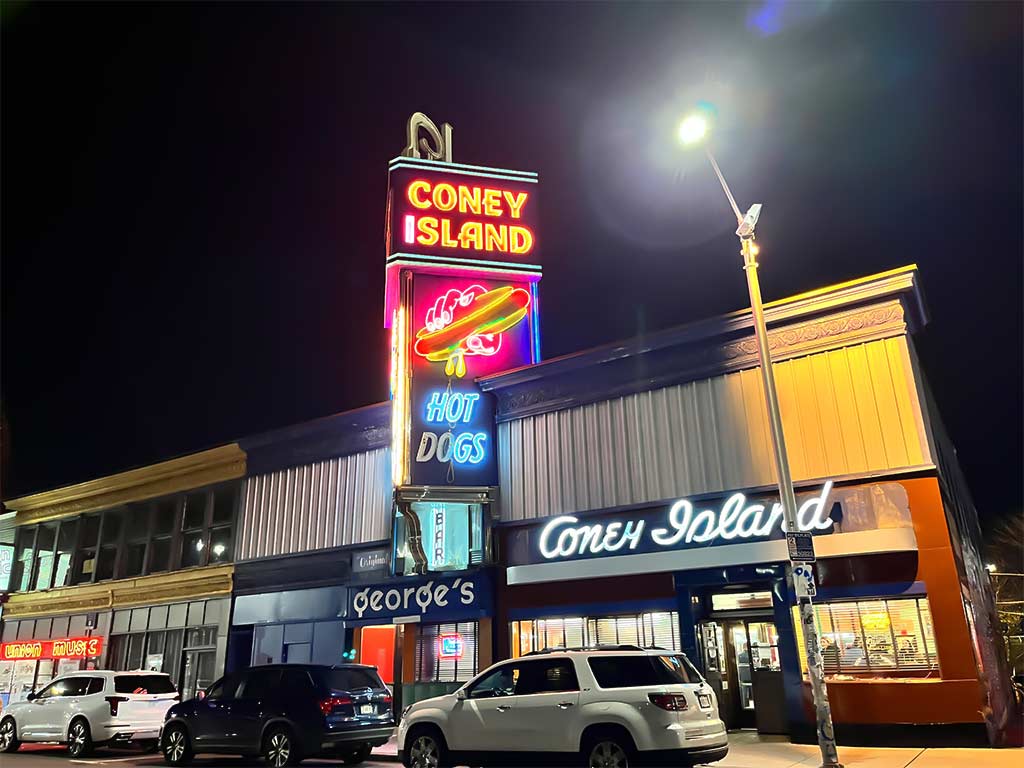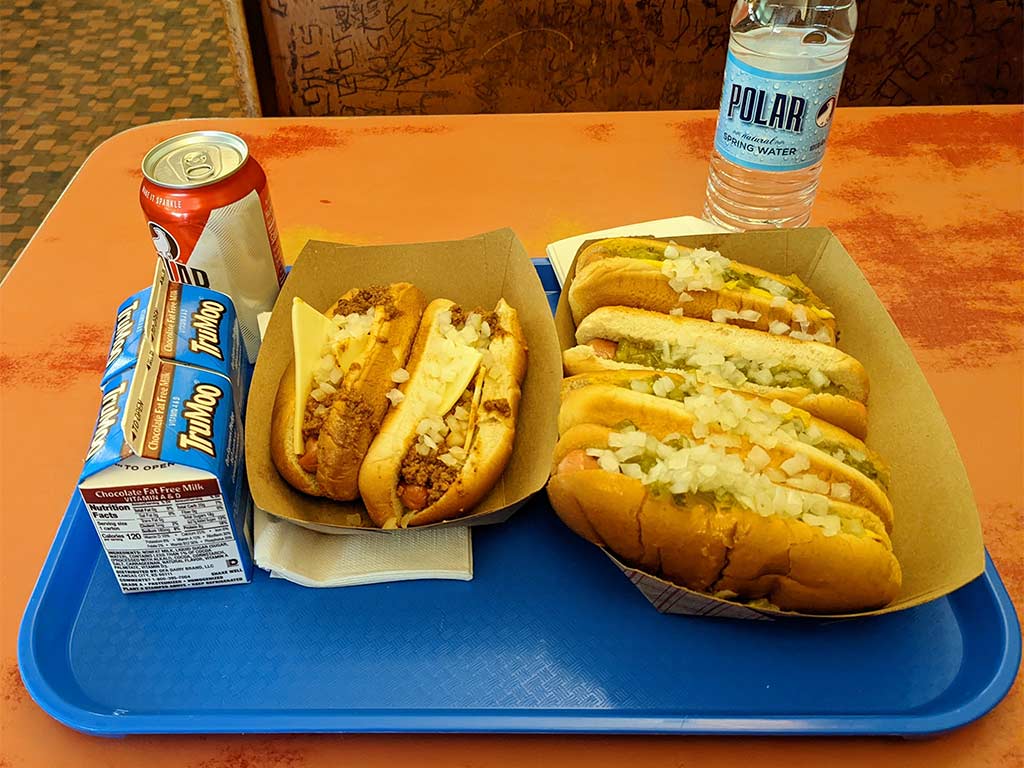If you’re a fan of hot dogs and intrigued by their historical roots, the Coney Island Worcester history is a fascinating tale worth exploring.
Back in 1918, a Greek couple, Catherine and George Tsagarelis, brought the trend of Coney Dogs to Worcester, setting the stage for a culinary legacy that endures to this day.
Their humble lunch counter on Southbridge Street became synonymous with the iconic neon sign of Georges Coney Island, a landmark that has etched itself into the fabric of American food culture.
As you delve into the evolution of the Coney Dog, you’ll discover how this simple yet beloved dish has weathered the changing tides of culinary preferences.
Despite the shifts in taste over the years, Georges Coney Island has remained a steadfast beacon for those seeking a taste of tradition and nostalgia.
Through the heartfelt accounts of customers who have savored these hot dogs through generations, the Coney Island Worcester history comes alive, reflecting not just a culinary tradition but a cherished part of American heritage.
Historical Roots of Coney Island Worcester

Coney Island Worcester, also known as Coney Island Hot Dogs or simply Coney Dogs, has a rich historical background deeply ingrained in the culinary and cultural fabric of Worcester, Massachusetts.
Here’s an exploration of its historical roots:
Early Beginnings and Namesake
The historical roots of Coney Island Worcester trace back to the arrival of a Greek couple, Catherine and George Tsagarelis, who introduced the iconic Coney Dogs to the city in 1918.
The name “Coney Island” was chosen to evoke the nostalgic imagery and flavors associated with the original Coney Island in New York, where hot dogs became a culinary sensation.
The Tsagarelis couple’s vision and culinary expertise laid the foundation for what would become a beloved culinary tradition in Worcester.
Evolution Through the Decades
Over the decades, Coney Island Worcester evolved from a humble hot dog stand to a cultural landmark, serving generations of loyal customers with its signature Coney Dogs.
The establishment’s evolution mirrored the changes in American food culture, adapting to new tastes while preserving the essence of its traditional recipes.
As Worcester grew and changed, George’s Coney Island remained a constant, serving as a beacon of tradition and nostalgia in the culinary landscape.
The enduring appeal of Coney Island Worcester reflects not just a culinary legacy but also a cherished part of American heritage, continuing to delight patrons with its timeless hot dogs.
Culinary Traditions and Innovations

Culinary traditions and innovations have played a significant role in shaping Worcester’s culinary landscape, contributing to its diverse and vibrant food scene.
Here are some key aspects of these traditions and innovations:
Famous Hot Dogs and Their Cultural Impact
George’s Coney Island in Worcester has become renowned for its iconic hot dogs, particularly the Coney Island dog, which has left a lasting cultural impact on the city.
The Coney Island hot dog is a delectable combination of a beef-and-pork Kayem frank topped with yellow mustard, freshly chopped raw onions, and the restaurant’s signature chili sauce.
This classic hot dog, also known as a “dog served up” or “with the works,” embodies the essence of Coney Island Worcester’s culinary traditions.
The popularity of these hot dogs extends beyond mere taste; they hold historical significance as well. Nathan Handwerker, a Polish immigrant who revolutionized the hot dog industry with his stand in Coney Island, New York, paved the way for hot dogs to become an American culinary staple.
George’s Coney Island in Worcester pays homage to this culinary legacy, offering locals and visitors alike a taste of history with each bite of their famous hot dogs.
Expansion of the Menu Over Time
While George’s Coney Island has remained true to its roots by preserving its original hot dog recipes, the restaurant has also embraced innovation by expanding its menu over the years.
What started as a humble hot dog stand in 1918 has evolved into a full-fledged restaurant catering to a diverse range of tastes and preferences.
In addition to their classic hot dogs, George’s Coney Island now offers an array of menu options to cater to modern palates while still honoring tradition.
From savory burgers and sandwiches to refreshing salads and sides, the menu at George’s Coney Island reflects the restaurant’s commitment to evolving with the times while staying true to its culinary heritage.
Architectural and Location Significance

The architectural and location significance of Worcester, Massachusetts, lies in its diverse array of historic and contemporary structures, as well as its strategic position within New England.
Here’s an exploration of these aspects:
Notable Buildings and Renovations
When you step into Georges Coney Island, you are greeted by a piece of Worcester’s history embodied in the architectural elements of the restaurant.
The 80-year-old wooden booths stand as a testament to the generations of Worcesterites who have left their mark by carving their names into them, creating a nostalgic ambiance that resonates with the city’s past.
he booths have accumulated decades’ worth of graffiti, reflecting a more innocent era where teenagers claimed their territory or expressed love for their high school sweethearts.
These historical artifacts, along with the meticulously maintained hot dog stand, provide a glimpse into the rich heritage of Worcester’s culinary landscape.
In 1938, Georges Coney Island underwent a significant transformation when it introduced the iconic wooden booths, marking a pivotal moment in the restaurant’s evolution.
The addition of these booths, which still retain the charm of yesteryears, complemented the existing chairs inherited from the previous corner lunch spot.
This blend of old and new architectural elements creates a unique dining experience that captures the essence of traditional American diners while embracing modern comforts.
Moreover, the preservation of the original artifacts, including a displayed historical chair, underscores the restaurant’s commitment to honoring its storied past while embracing the present.
Geographic Influence on Worcester’s Development
Georges Coney Island not only holds historical significance within Worcester but also contributes to the broader geographic landscape of the city.
Situated at 158 Southbridge St in Worcester, MA, this iconic eatery has become a focal point for locals and visitors alike, shaping the cultural fabric of the neighborhood.
The strategic location of Georges Coney Island has played a pivotal role in defining Worcester’s culinary identity, drawing in patrons from far and wide who seek a taste of authentic Coney Island hot dogs.
The famed neon sign adorning Georges Coney Island’s facade, designed in 1940 by Russian immigrant S.C. Romanoff, stands as a towering beacon that symbolizes the city’s culinary prowess.
The 40-foot-high neon sign featuring a colossal hand holding a mouthwatering hot dog exudes a sense of nostalgia and tradition, serving as a visual landmark that signifies the restaurant’s enduring legacy.
Its prominence in Worcester’s architectural landscape not only adds to the city’s charm but also evokes a sense of pride among locals who recognize it as a cultural emblem.
By intertwining architectural heritage with geographical significance, Georges Coney Island transcends being just a dining establishment to become a living testament to Worcester’s past, present, and future.
The fusion of historical elements with modern amenities not only enhances the dining experience but also reinforces the restaurant’s status as a cherished culinary icon in Worcester’s vibrant tapestry.
Memorable Events and Community Impact
Worcester, Massachusetts, has been home to numerous memorable events and community initiatives that have left a lasting impact on its residents and visitors.
Here are some examples:
Celebrated Occasions at Coney Island
Over its 105 years of operation, George’s Coney Island has become synonymous with memorable events and celebrations.
From its humble beginnings in 1918 to its recent milestone anniversary, the eatery has been a cornerstone of the Worcester community.
The announcement of 105 days of celebration for its 105th year demonstrates the establishment’s commitment to honoring its history and engaging with patrons in a meaningful way.
The kickoff event, featuring a special barbecue hot dog with homemade sweet hickory smoked bacon sauce, exemplifies the fusion of tradition and innovation that defines George’s Coney Island.
By offering unique menu items and hosting special events throughout the year, the restaurant continues to create lasting memories for its customers while staying true to its roots.
Contributions to Local Charities and Causes
Beyond serving delicious hot dogs, George’s Coney Island has made significant contributions to local charities and causes, further solidifying its impact on the Worcester community.
Through initiatives aimed at giving back and supporting those in need, the restaurant has become a pillar of philanthropy in the area.
By engaging with various charitable organizations and causes, George’s Coney Island demonstrates a deep commitment to supporting the community that has embraced it for over a century.
Whether through fundraisers, donations, or volunteering efforts, the establishment continues to play a vital role in improving the lives of Worcester residents and fostering a sense of unity and support among locals.
Frequently Asked Questions
What year was George’s Coney Island in Worcester established?
George’s Coney Island in Worcester was established in 1918.
What are some iconic features of George’s Coney Island?
George’s Coney Island introduced Coney Dogs, added wooden booths in 1938, and has a famed neon sign designed in 1940.
Where is George’s Coney Island located?
George’s Coney Island is located at 158 Southbridge St, Worcester.
How long has George’s Coney Island been in operation?
George’s Coney Island is celebrating its 105th year in operation.
How does George’s Coney Island contribute to the community?
George’s Coney Island supports local charities through fundraisers, donations, and volunteering efforts.
What makes George’s Coney Island stand out?
George’s Coney Island intertwines Worcester’s past, present, and future while honoring its history through special events and unique menu items.
Conclusion
You’ve delved into the captivating history and architectural significance of George’s Coney Island in Worcester, a culinary gem dating back to 1918.
From its iconic neon sign to the blend of traditional diner elements with modern comforts, this establishment has stood the test of time.
Celebrating 105 years of rich heritage, George’s Coney Island continues to be a beacon of community engagement and culinary innovation.
Its commitment to preserving history while embracing the future through special events and philanthropic endeavors cements its place as a beloved cultural landmark in Worcester.
George’s Coney Island’s legacy is not just about food; it’s a testament to the enduring spirit of a place that has woven itself into the fabric of Worcester’s identity.
Jaclyn Lowe